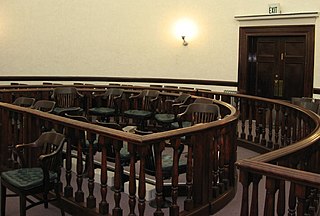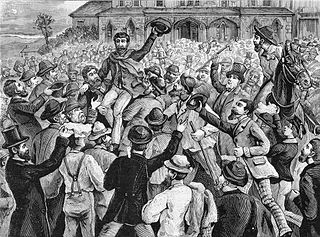Related Research Articles
Jury instructions, directions to the jury, or judge's charge are legal rules that jurors should follow when deciding a case. They are a type of jury control procedure to support a fair trial.

A jury trial, or trial by jury, is a lawful proceeding in which a jury makes a decision or findings of fact. It is distinguished from a bench trial in which a judge or panel of judges makes all decisions.

A jury is a sworn body of people convened to render an impartial verdict officially submitted to them by a court, or to set a penalty or judgment. Juries developed in England during the Middle Ages, and are a hallmark of the Anglo common law legal system. They are still commonly used today in Great Britain, the United States, Canada, Australia, and other countries whose legal systems are descended from England's legal traditions.
Judgment notwithstanding the verdict, also called judgmentnon obstante veredicto, or JNOV, is a type of judgment as a matter of law (JMOL) that is sometimes rendered at the conclusion of a jury trial. In U.S. federal civil court cases, the term has been replaced by the renewed judgment as a matter of law, which emphasizes its relationship to the judgment as a matter of law, formerly called a directed verdict. In U.S. federal criminal cases, the term is "judgment of acquittal".
Jury nullification (US), jury equity (UK), or a perverse verdict (UK) refers to when members of a criminal trial's jury believe that a defendant is guilty, but choose to acquit the defendant anyway. Reasons may include beliefs that: the law itself is unjust, the prosecutor has misapplied the law in the defendant's case, the punishment for breaking the law is too harsh, or general frustrations with the criminal justice system. Some juries have also refused to convict due to their own prejudices in favor of the defendant.
In criminal law, diminished responsibility is a potential defense by excuse by which defendants argue that although they broke the law, they should not be held fully criminally liable for doing so, as their mental functions were "diminished" or impaired.

In common law jurisdictions, an acquittal certifies that the accused is free from the charge of an offense, as far as the criminal law is concerned. The finality of an acquittal is dependent on the jurisdiction. In some countries, such as the United States, an acquittal operates to bar the retrial of the accused for the same offense, even if new evidence surfaces that further implicates the accused. The effect of an acquittal on criminal proceedings is the same whether it results from a jury verdict or results from the operation of some other rule that discharges the accused. In other countries, the prosecuting authority may appeal an acquittal similar to how a defendant may appeal a conviction.

In law, a verdict is the formal finding of fact made by a jury on matters or questions submitted to the jury by a judge. In a bench trial, the judge's decision near the end of the trial is simply referred to as a finding. In England and Wales, a coroner's findings used to be called verdicts but are, since 2009, called conclusions.
In United States law, a motion is a procedural device to bring a limited, contested issue before a court for decision. It is a request to the judge to make a decision about the case. Motions may be made at any point in administrative, criminal or civil proceedings, although that right is regulated by court rules which vary from place to place. The party requesting the motion may be called the moving party, or may simply be the movant. The party opposing the motion is the nonmoving party or nonmovant.
A hung jury, also called a deadlocked jury, is a judicial jury that cannot agree upon a verdict after extended deliberation and is unable to reach the required unanimity or supermajority. Hung jury usually results in the case being tried again.
Not proven is a verdict available to a court of law in Scotland. Under Scots law, a criminal trial may end in one of three verdicts, one of conviction ("guilty") and two of acquittal.
Jury tampering is the crime of unduly attempting to influence the composition and/or decisions of a jury during the course of a trial. The means by which this crime could be perpetrated can include attempting to discredit potential jurors to ensure they will not be selected for duty. Once selected, jurors could be bribed or intimidated to act in a certain manner on duty. It could also involve making unauthorized contact with them for the purpose of introducing prohibited outside information and then arguing for a mistrial. In the United States, people have also been charged with jury tampering for handing out pamphlets and flyers indicating that jurors have certain rights and obligations, including an obligation to vote their conscience notwithstanding the instructions they are given by the judge.
Unanimity is agreement by all people in a given situation. Groups may consider unanimous decisions as a sign of e.g. social, political or procedural agreement, solidarity, and unity. Unanimity may be assumed explicitly after a unanimous vote or implicitly by a lack of objections. It does not necessarily mean uniformity and can sometimes be the opposite of majority in terms of outcomes.
Beyond a reasonable doubt is a legal standard of proof required to validate a criminal conviction in most adversarial legal systems. It is a higher standard of proof than the balance of probabilities and is usually therefore reserved for criminal matters where what is at stake is considered more serious and therefore deserving of a higher threshold.

The criminal law of Canada is under the exclusive legislative jurisdiction of the Parliament of Canada. The power to enact criminal law is derived from section 91(27) of the Constitution Act, 1867. Most criminal laws have been codified in the Criminal Code, as well as the Controlled Drugs and Substances Act, Youth Criminal Justice Act and several other peripheral statutes.

The court of assizes is the trial court which tries the most serious crimes in the judicial system of Belgium. It is the highest Belgian court with criminal jurisdiction, and as such, it is the only Belgian court that can sentence someone to life imprisonment. The courts of assizes are not permanent courts; a new court of assizes is assembled for each new trial. There is a court of assizes in each of the ten provinces of Belgium, and one in the arrondissement of Brussels-Capital. Further below, an overview is provided of the eleven courts of assizes and their seats. They are the only courts in Belgium for which the provinces are used as territorial subdivisions. They are also the only courts in Belgium that hold jury trials. The jury acts as sole trier of fact, but decides on the penalty together with the judges. The trial by jury of certain crimes is laid down in article 150 of the Belgian Constitution. The Belgian courts of assizes have the same origin as their French namesakes.
Apodaca v. Oregon, 406 U.S. 404 (1972), was a United States Supreme Court case in which the Court held that state juries may convict a defendant by a less-than-unanimous verdict in a felony criminal case. The four-justice plurality opinion of the court, written by Justice White, affirmed the judgment of the Oregon Court of Appeals and held that there was no constitutional right to a unanimous verdict. Although federal law requires federal juries to reach criminal verdicts unanimously, the Court held Oregon's practice did not violate the Sixth Amendment right to trial by jury and so allowed it to continue. In Johnson v. Louisiana, a case decided on the same day, the Court held that Louisiana's similar practice of allowing criminal convictions by a jury vote of 9–3 did not violate due process or equal protection under the Fourteenth Amendment.
United States criminal procedure derives from several sources of law: the baseline protections of the United States Constitution, federal and state statutes; federal and state rules of criminal procedure ; and state and federal case law. Criminal procedures are distinct from civil procedures in the US.
A citizen’s right to a trial by jury is a central feature of the United States Constitution. It is considered a fundamental principle of the American legal system.

Trial by jury in Scotland is used in the courts of Scotland in solemn procedure for trial on indictment before a judge and jury for serious criminal cases, and in certain civil cases
References
- ↑ Hill, Gerald N.; Hill, Kathleen (2002). The people's law dictionary : taking the mystery out of legal language. New York, NY: MJF Books. ISBN 9781567315530.